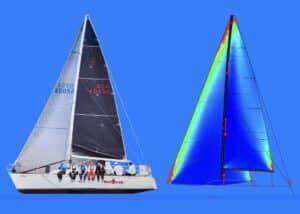Professional sailors often race around the course in close quarters because there is relatively little difference in their skill levels than most Corinthians. Learning by watching the pros race offers plenty of lessons of their close quarter maneuvers.
This recent clip was put up on the RC44 Instagram page. It shows two starboard tack boats battling it out as they approach the leeward gate, IKA (to windward) and HRASTNIK 1860 (to leeward). Ahead of them is a third boat who has already rounded the gate and was on her way back upwind on starboard. That third boat represented an obstruction to both spinnaker boats as she is the leeward boat that the two spinnaker boats have to keep clear of. When the windward spinnaker boat (IKA) jibes to port, she is still entitled to room from the starboard tacker HRASTNIK 1860 at the obstruction. But the definition of room does not entitle the inside boat any more than the space she needs to meet her obligation to keep clear. Therefore, as long as she can keep from hitting the two other boats, she was given enough room. Thus, IKA on port alters her course to sail dead downwind to avoid HRASTNIK 1860.
Once the HRASTNIK 1860 jibes, both boats are on port tack. Now, HRASTNIK is the windward boat and must keep clear of IKA. Notice how quickly the right of way moves from one boat to the other. Clearly a “pro move!”
Since IKA is the inside leeward boat at the port gate mark, she is entitled to do a tactical rounding – wide approaching the mark and then tight as she passes it — which she does nicely. Notice how IKA sets up her turn to sail right next to the mark as she passes it. Knowing that IKA will be ahead at the port gate, HRASTNIK 1860 opts to sail around the starboard gate mark. When an inside boat is a windward boat, she cannot make a tactical rounding as she is only entitled the room needed to get around the mark. It is only when the inside boat is also the the right of way boat that she can make a tactical rounding.
Editor’s Note: I know from experience about the definition of room. I learned this lesson well as the result of being protested for not giving enough room. At Block Island Race Week in 1999, I was racing my boat SOULMATES in a seven-boat Express 37 one-design class. I was bow-to-bow with another Express 37 as we approached the finish pin on a dead run. To keep my speed up, I had to sail as hot an angle as I could; but I had to give an inside boat room at the pin. Being the leeward boat, I pushed the other boat as close to the pin as I could. Its skipper protested me for not giving him room. After the race, instead of going to the beer tent, I had to go to the protest room. Luckily, the Storm Trysail Club, the race organizers, were early adopters of pre-hearing arbitration. None other than Arthur “Tuna” Wullschleger, one of the best international judges and creator of the arbitration rule, held the hearing. After the protestor went through what happened, Tuna asked him two questions, “Did you hit the mark? Did you hit SOULMATES?” When the protester said no to both questions, Tuna said, “It sounds to me like you got enough room and I suggest you drop your protest.” When Tuna asked me if I had anything I wanted to add, I quickly replied, “No sir,” knowing that anything I might say would only hurt my position. That was it, the case was closed and off to the party tent I went.




